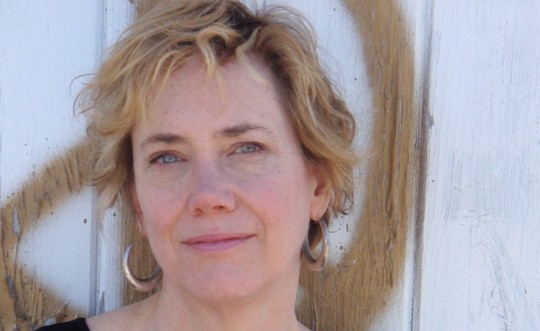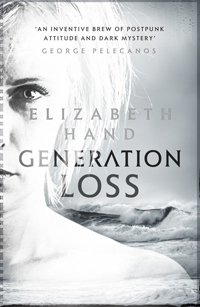A lapsed Catholic whose father was a New York State judge for 40 years, and whose mother read crime voraciously, Elizabeth Hand had her first novel published at 33. Her many successful forays into contemporary dark fantasy were followed in 2008 by her first crime novel, Generation Loss which introduced the messed-up punk photographer Cass Neary. The character, who seems to attract trouble of a murderous nature, appears again in Available Dark, and both the novels have been picked up for UK publication by Constable and Robinson. They’ve also both scored five stars here on Crime Fiction Lover, so we invited Elizabeth Hand onto the site for an interview…
You were already having success with your fantasy books. What made you decide to write crime?
As a kid I loved noir films, which were always on TV in the New York area where I grew up – Nightmare Alley, The Maltese Falcon, To Have and Have Not, The Long Goodbye – along with Hitchcock’s work. In my teens I got turned on to classic European noir movies like M, Breathless, The Third Man, Odd Man Out. My mother was a voracious reader and still reads a lot of crime fiction, so I’d often pick up whatever she was reading. I was also reading a lot of true crime books, inspired by the weekly Justice Story which ran in the NY Daily News. These were accounts of very noir-ish, often grisly crimes with accompanying photos by folks like WeeGee. As a kid I was fascinated and repelled by them in equal measure.
So without realising it, I actually had a pretty decent grounding in crime fiction. As an adult I loved Patricia Highsmith, Graham Greene, Peter Hoeg, Kirstin Ekman, but my biggest influence was Kem Nunn’s brilliant surfpunk noir novel Tapping the Source. I read that when it came out in 1984 and it just blew me away, the way Bill Gibson’s Neuromancer did when I read it the same year.
I always wanted to try my hand at that kind of noir novel. I was active in the proto-punk scene in NYC and DC in the 1970s, and Tapping the Source made it clear how much punk fitted into the noir mode, something you saw in films like Liquid Sky and Jim Jarmusch’s work, but not so much in fiction. It just seemed like an obvious match. I knew the territory, I knew the kind of people involved with it, I knew the mindset.
Tell us about how you invented Cass Neary and all her quirks, like hiding someone’s keys in the sea urchin shell in Generation Loss?
I’ve always said that Cass is me if my emotional and psychological brakelines had been cut when I was 22. Cass is damaged because she’s traumatised and she’s spent her entire adult life denying that fact, at a terrible psychic cost. Many of her experiences are my own, including being raped. Unlike Cass, I was able to move through that and eventually find my way as an artist.
Yet Cass has a certain resilience that has made it possible for her to survive despite alcoholism, drugs, severe emotional disassociation. She’s really a borderline socoipath, if not a full-blown one. In Generation Loss, she begins to move away from the self-inflicted emotional lockdown she’s endured for the last several decades but that kind of action, after such a prolonged period of disengagement, can also be extraordinarily deracinating, even terrifying. It brings its own derangement.
The fucked-up stuff she does, like hiding some poor stranger’s keys inside a sea urchin – she doesn’t even think about what she’s doing, or the consquences. She’s all id: she has no super-ego to mediate for her, no brakes. She’s on a collision course with her own future, and it’s a scary ride.
Everyone brings up that sea urchin. I never do stuff like that – screwing with random people’s heads in the most random, senseless way. But I like to think about it.
As messed up as Cass is, her adversaries turn out to be pretty insane too. For you, what are the ingredients for the ultimate crime fiction villain?
I read a lot of true crime accounts, because the truth is often so much weirder and banal and senseless than what you find in fiction. I’m always stunned by the things that motivate people to commit such horrific acts, from the bizarre personal mythologies of certain real-life serial killers to the utterly mindless, banal murders triggered by road rage or domestic boredom or the anguish of a lonely teenager.
I’m not a sociopath, but I’ve known some and observed others. They can be very unpredictable. Narcissism can be such a profound part of their psychological makeup that, like Cass, they can go through life and at times literally not register, or value, the life of another human being. So I tend to like sociopathic villains. But then, who doesn’t?
Why were you drawn to coastal Maine, and then Finland and Iceland, as settings for the Cassandra Neary novels?
These are places I’ve always loved. I’ve lived on the coast of Maine for 25 years, and in many ways it’s very similar to places like Iceland and Finland and Sweden. They all share an intense physical beauty coupled with a genuine bleakness, both spiritual and visual. Maine is a tough place to live. There’s a great deal of poverty, a lot of depression, a lot of self-medicating with drugs and alcohol. There’s often resentment on the part of natives toward people from away. In the islands and smaller communities like the one I live, you often have witch hunts, where relative outsiders literally become outcasts. It’s beautiful here, but it can very suddenly get very ugly, and scary. There’s a kind of human weather that can shift as suddenly and dangerously at the actual weather. I spend a great deal of time in the UK as well, which is also often dark and cold.
WH Auden talks about the quality of northernness, which he loved, and which I do as well. Finland especially is like nowhere else on Earth. I love Finland and the Finns. I guess I just have a northern temperament.
What’s next for Cass Neary?
In the third novel, Flash Burn, Cass finds herself in London on a stolen passport, involved with a gangster with a penchant for giftwrapping, black market antiquities, aging groupies, an experimental 60s filmmaker gone to seed, and the visionary American photographer who inspired the Church of Satan.











